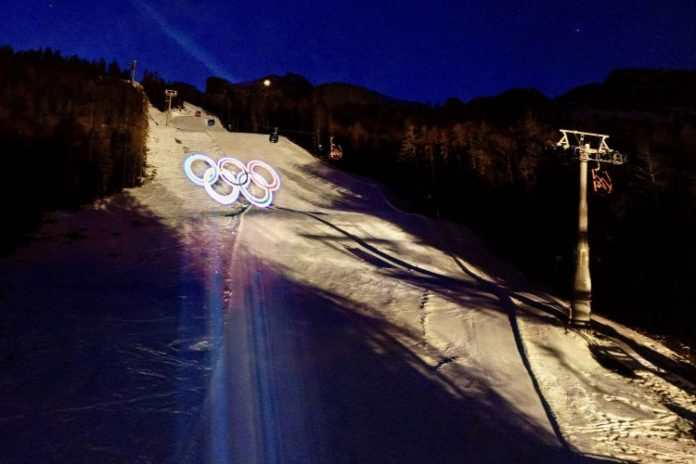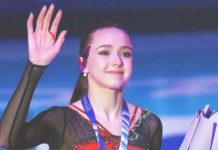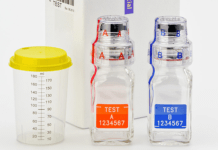
★ The Sports Examiner: Chronicling the key competitive, economic and political forces shaping elite sport and the Olympic Movement.★
★ To get The Sports Examiner by e-mail: sign up here! ★
★ Fabulous! A 24th donor has helped reach 50% of our goal to cover technical and support costs. Can you join in? Please consider a donation to help keep TSX going. Thank you. ★
≡ THE 5-RING CIRCUS ≡
1. Valieva decision published: “Grandfather Explanation” rejected
2. Cortina marks two years to go with 100-skier parade
3. Paris police chief warns Olympic “life” will be different
4. USADA’s Tygart calls for sports anti-crime agency
5. ESPN-FOX-WBD tie-up erupts to change U.S. television landscape
● The Court of Arbitration for Sport published the complete, 129-page decision in the Kamila Valieva doping appeal, finding that her use of trimetazidine was “intentional” within the meaning of the World Anti-Doping Code, but was careful not to brand her as a “cheater.” It rejected her primary defense of contamination from a glass or a dessert from her grandfather, and also explained the delay at the Stockholm lab which processed her sample.
● Guest correspondent Brian Pinelli captured the scene in Cortina d’Ampezzo as the two-years-to-go celebrations were made for the 2026 Olympic Winter Games there and in Milan. On Wednesday, the Milan-Cortina organizers also unveiled mascots Tina and Milo for the Olympic and Paralympic Winter Games.
● In an interview, the head of the Paris Police confirmed that there will be access restrictions in several areas related to the Olympic and Paralympic Games, but that accommodations have been made to allow life to go on – with some added protocols – during the event periods. But things will not be normal.
● The head of the U.S. Anti-Doping Agency told a conference in Norway that an “anti-crime” agency for sports needs to be set on a worldwide basis, as was the World Anti-Doping Agency 25 years ago. Issues of abuse and competition manipulation are growing and need to be independently addressed, although how a criminal enforcement project would work is unknown.
● A major shake-up in sports television in the U.S. was announced Tuesday, with 14 channels from ESPN, FOX and Warner Bros. Discovery to be combined into a single streaming application, possibly costing $40-50 a month. But Olympic sports and events are likely to be little impacted as NBC has most of them; however, the profile of these events may be lowered if the new combo pack takes off.
● World Championships: Aquatics (3: van Rouwendaal completes open-water sweep; China scores twice more in diving; Minisini wins 10th career artistic medal) ●
● Panorama: U.S. Olympic & Paralympic Committee (U.S. teams set to stay in Eaubonne for training) = Russia (Former Sochi 2014 head says Russia going its own way now) = Athletics (3: Katir suspended for whereabouts; Saruni arranged for lookalike to take a 2022 doping test; Sauders says she’s done with track after five more meets) = Cycling (Glasgow Worlds has economic impact of more than $250 million) = Football (UEFA distribution formula for $4.7 billion from 2024-27 men’s club events) = Wrestling (NCAA signals approval of women’s wrestling for 2025-26!) ●
1.
Valieva decision published: “Grandfather Explanation” rejected
The Court of Arbitration for Sport published the full, 129-page version of the arbitration decision concerning Russian skater Kamila Valieva and her doping positive from 25 December 2021, in which it upheld an appeal from the World Anti-Doping Agency and others and imposed a four-year sanction.
There was no doubt about the presence of Trimetazidine, a prohibited substance, in her sample. The question was how she ingested it. In the decision, it was stated that Valieva thought she might have taken a drink from the same glass that her grandfather had used at a lunch they had together on a training day; her grandfather was taking Trimetazidine at the time for a heart condition and had crushed the pills and mixed them in the glass with water. Or, one of the pills might have gotten into a dessert she ate there, or later.
The various appeals submittals from RUSADA, the International Skating Union and the World Anti-Doping Agency all agreed on the doping positive, with RUSADA’s view that the ingestion of the Trimetazidine was likely unintentional. The ISU appeal cast doubt on the grandfather story all together and believed that Valieva was taking the drug intentionally:
“The Athlete was taking Hypoxen and L-carnitine. There is expert evidence to suggest that TMZ has a synergistic relationship with these substances.”
The ISU asked for a four-year sanction, but would also accept a two-year sanction if the CAS panel found her ingestion of the drug to be involuntary.
The World Anti-Doping Agency’s position was that “The Grandfather Explanation ‘has no evidentiary basis whatsoever’ and ‘is more or less entirely unsubstantiated,’” and asked for a four-year sanction. Moreover, its submittal emphasized that:
“TMZ is recommended for use in Russian sport. It has been recommended in the Russian National Guidelines on Sports Medicine and a review of the scientific literature in Russia shows that ‘TMZ is widely recommended in elite sport in particular in support of the heart in connection with heavy training’ – in circumstances where the Athlete was diagnosed with a heart condition at the end of 2020.”
Valieva’s submittals rejected the appeal arguments and insisted that her ingestion of the drug was unintentional.
The arbitrator’s decision was that, beginning with the 2015 version of the World Anti-Doping Code, an intentional doping violation should carry a minimum four-year sanction, even for minors. And a doping charge is essentially presumed to be “intentional” if the actual source of the drug cannot be shown:
“While it is theoretically possible for an Athlete or other Person to establish that the anti-doping rule violation was not intentional without showing how the Prohibited Substance entered one’s system, it is highly unlikely that in a doping case under Article 2.1 an Athlete will be successful in proving that the Athlete acted unintentionally without establishing the source of the Prohibited Substance.”
The arbitrators discounted the ISU and WADA notices of the use of Trimetazidine in Russian sports medicine as out of date, but did note that the drug is effective in increasing oxygen in the body, a benefit for harder training, and that due to side effects, is generally not prescribed to minors.
The bottom line:
“In light of the fact that the Athlete has not established, on the balance of probabilities, that she did not commit the ADRV intentionally, it must follow that the period of ineligibility is four years.”
The opinion did indicate that the panel was split, 2-1, on the length of the sanction, between two years and four years, but not on the question of a sanction for doping. It was also explicitly noted that Valieva was not found to be a “cheat,” but that she could not show grounds which would relieve her of a sanction for an “intentional” – as defined – doping finding.
¶
The decision also illuminated the questions surrounding the delay of the Stockholm testing lab to which Valieva’s samples were sent. The lab was closed from 30 December to 10 January 2022, then resumed testing and got a positive result for Trimetazidine on 11 January. It re-tested the sample, but had three straight failures of its quality-assurance tests. It took from 20 January to 3 February to prepare a new protocol – and for some of the Stockholm lab staff to return from Covid-19 infections – which confirmed the testing validity on 7 February. The Russian Anti-Doping Agency was informed of the confirmed positive test on 8 February.
In the meantime, the Beijing 2022 Olympic Winter Games Team Event in figure skating concluded on 7 February.
Valieva was suspended by RUSADA on 8 February and she immediately appealed to the independent Disciplinary Anti-Doping Committee, which made a finding of “no fault” and ended her suspension, allowing her to continue competing at the Winter Games. Her situation was the subject of a review of a hearing by the Court of Arbitration for Sport ad hoc division for doping at the Winter Games and allowed to compete pending an after-Games investigation.
2.
Cortina marks two years to go with 100-skier parade
The Olympic Winter Games in Milan and Cortina d’Ampezzo, Italy, will open on 6 February and programs were mounted in both locations for the two years-to-go date. Guest correspondent Brian Pinelli reported on the festivities in Cortina:
Excitement is quickly ramping up as celebrations were held in Cortina d’Ampezzo; the date marked exactly two years until the opening ceremony at San Siro Stadium in Milan.
Festivities in Cortina on Tuesday evening kicked off with a torchlight parade of local skiers descending Col Druscie, the women’s 2026 Olympic Slalom trail, followed by the lighting of Olympic Rings on the mountain, all visible from the center of town below.
Cortina d’Ampezzo mayor Gianluca Lorenzi hosted the party in town, while expressing great enthusiasm, and a little bit of nervousness, in welcoming the winter sports athletes in 24 months.
“It will be amazing because in just two years we will be here along with the Olympic athletes and it will all be like a dream,” Lorenzi said. “There is already so much emotion here getting ready for Olympic Games.
“The feeling is amazing, but it is not so easy to comprehend what the Olympics will be like in Cortina, once again after 70 years.”
Cortina d’Ampezzo previously hosted the VII Winter Games in 1956.
“We will have about 1,200 athletes here and I hope after they return home it will be a dream for their whole life,” the Cortina mayor said.
Women’s Alpine skiing on the Olympian delle Tofane and Col Drusciè slopes, curling at the 1956 Olympic Ice Stadium, and bobsleigh, skeleton and luge at the Eugenio Monti Olympic Track – which just received the green light to be reconstructed last Friday (2nd) – are all planned to be held in the venerable Italian Dolomites resort.
Italian three-time Olympic medalist and 2020 overall World Cup champion Federica Brignone is thrilled about her country once again welcoming the world at the XXV Olympic Winter Games.
“I think it will be really important, just amazing, for our nation to have the Olympic Games once again,” Brignone said. “If you participate as an athlete, you will be part of the show.
“Our sport has changed a lot since 1956 and Milano Cortina 2026 is going to be really nice,” said the Italian three-time Olympic medalist. “The Olympic and winter spirit will really shine.”
Men’s Alpine ski races will be contested in Bormio on the Stelvio piste, a regular stop on the FIS World Cup circuit. In Milan, where ice events will be held, the Olympic Rings and Paralympic Agitos were unveiled in Piazza della Scala on Tuesday.
(For more, visit Brian Pinelli on Twitter and Instagram)
¶
The Milan Cortina organizers also officially revealed the Games mascots Tina and Milo, two stoats (ermines), with “Tina” taking her name from Cortina and “Milo” from Milan.
They were unveiled at the Sanremo Music Festival on Wednesday; Tina will represent the Olympic Winter Games and Milo the Winter Paralympic Games.
They were selected from a schools contest which drew 1,600 entries with the winning concept from the Istituto Comprensivo of Taverna from the region of Calabria. Tina and Milo are accompanied by six snowdrops, inspired by the other finalist concept submitted by the Istituto Comprensivo Sabin of Segrate in Lombardia.
3.
Paris police chief warns Olympic “life” will be different
“Life won’t be as it was before.”
That’s the key takeaway from Laurent Nunez, the Paris Prefect of Police, in an interview with Agence France Presse on the traffic conditions for locals during the Olympic and Paralympic period this summer.
Nunez previously announced that access to Olympic and Paralympic venue areas in and around Paris would be restricted, with residents required to have a mobile phone and obtain a (free) QR code to allow access. The concept remains in place, but there have been accommodations made:
“The important part is that we have opened up the number of exemptions in order to reflect the reality of people’s personal and professional lives in order not to paralyse their activity, while also upholding our rules on security. ...
“There will be special lanes [for Olympic traffic], detours. But our message is that we are doing everything to ensure essential car journeys are possible.
“The delivery of packages or meals in a vehicle is not allowed, but will be possible on foot.”
He explained that taxi drivers, caregivers and emergency technicians – locksmiths, for example – would be able to enter restricted areas, provided they have registered their status ahead of time.
The exact outlines of the restricted areas are expected to be revealed by the end of February.
4.
USADA’s Tygart calls for sports anti-crime agency
The World Anti-Doping Agency was created in 1999. Now, 25 years later, Travis Tygart, the head of the U.S. Anti-Doping Agency, is calling for a similar body to be created to control crimes in sport.
He told the 2024 Play The Game Conference in Trondheim (NOR):
“There is an incredible need for it, particularly because of the sexual abuse cases in sport. It’s horrific stories. Sport has to care about individual lives who are being affected.
“And the manipulation of competitions as well. Just as in the anti-doping space, the public, broadcasters, and sponsors are not going to stand for sport that does not have a legitimate outcome. Fairness is at the heart of why we play sport in life. Sport is so valuable, so I think absolutely there is a need for it.”
The questions of what such an agency would look like, funded and staffed are all to be solved. But Tygart wants to start:
“It is only a matter of time before something happens. And then those who want to see change are going to be in a certain state of panic like the world of sport was back in 1999 and that ultimately led to the World Anti-Doping Agency being established.
“The dark side always exposes itself. In the U.S, we now have an unprecedented piece of legislation that gives 20 million dollars to the U.S. Center for SafeSport, an independent organization that tries to tackle these issues. There is a lot of ‘devil in the detail’ of how to make that truly effective, both in the U.S. but also around the world.
“It can’t be a political body where politicians are influencing the decisions. And then I think you need to have the proper authority. That means it cannot become an overly bureaucratic organization that through regulation attempts to control everyone and gets rid of the discretion and trust of those in the field who have to make difficult decisions.”
Ironically, Tygart, who has railed against the failures of the worldwide anti-doping system, still sees some sort of anti-crime agency that could come out of the same concept:
“We see incredible failures of the current anti-doping system. That does not erase all the great work. But a byproduct of all this regulation is that no one takes responsibility and let us be clear: We have a long way to go to win the gold medal for clean athletes.”
His comments came out of a seminar session titled, “Clearing Sport: Towards an agency countering crime and protecting integrity of sport?”
5.
ESPN-FOX-WBD tie-up erupts to change U.S. television landscape
Tuesday’s announcement of a forthcoming, direct-to-consumer mega-streaming package alters the American television market in a substantial way, but leaves the country’s Olympic television partner on the sidelines.
The announcement led with:
“ESPN, a subsidiary of The Walt Disney Company, FOX and Warner Bros. Discovery have reached an understanding on principal terms to form a new Joint Venture (JV) to build an innovative new platform to house a compelling streaming sports service.
“The platform brings together the companies’ portfolios of sports networks, certain direct-to-consumer (DTC) sports services and sports – including content from all the major professional sports leagues and college sports. The formation of the pay service is subject to the negotiation of definitive agreements amongst the parties.
“The offering, scheduled to launch in the fall of 2024, would be made available directly to consumers via a new app. Subscribers would also have the ability to bundle the product, including with Disney+, Hulu and/or Max.”
What this means is that 14 over-the-air and cable channels will be combined in a single offer:
● Disney (7): ABC, ESPN, ESPN2, ESPNU, SECN, ACCN, ESPNEWS
● Fox (4): FOX, FS1, FS2, BTN
● WBD (3): TNT, TBS, truTV
Baseball, college football, NFL, NBA, WNBA, NHL and a host of soccer fixtures will all be offered, but not the Olympic Games or any of the many sports contracted to NBC – such as the World Athletics meets and the Diamond League – and many U.S. national federation events. CBS, which has its own Paramount+ streaming service – is also not involved.
Pricing is being reported in the $40-50 per month range, so it isn’t going to be cheap, but the opportunity to bundle with other services could make a combined offer interesting for consumers.
Observed: What does this mean for American viewers of the Olympic Games or Olympic sports? In the short term, not much; to the extent such events are contracted to NBC – including the Olympic Games through 2032 and the upcoming U.S. Olympic Trials events – they will continue as before.
But what this tie-up does is further erode the visibility of Olympic sport in the U.S. Beyond the Olympic Games, NBC has moved much of its Olympic-sport programming to the Peacock streaming service, which continues as a separate entity, at $6 and up per month. To the extent that the new three-network app absorbs fan interest, eyeballs and money – and its forthcoming impact is unknown – it further relegates Olympic-sport events off people’s schedules. To the extent it diminishes – if at all – Peacock’s share among sports fans, it lowers American Olympic sport’s presence.
Nielsen reported that, in December 2023, over-the-air and cable viewing accounted for 51.5% of all U.S. television viewing, with 35.9% streaming and 12.5% for other uses, such as video games. Streaming advanced from 32.8% in January of 2023, a 9.5% gain in one year.
With the implosion of newspapers continuing nationally, the opportunities for U.S. Olympic sports to obtain awareness and impact are already challenging. As none of the three U.S. entities that are part of this new streaming venture have much at all to do with America and the Olympics, it’s another worry point for the U.S. Olympic & Paralympic Committee and the National Governing Bodies.
≡ WORLD CHAMPIONSHIPS ≡
● Aquatics ● Day six of the World Aquatics Championships in Doha (QAT) featured the two 5 km open-water events, with Rio 2016 Olympic and 2024 Worlds 10 km champ Sharon van Rouwendaal (NED) completing her sweep of the Doha women’s events.
Trailing Australia’s Chelsea Gubicka into the final half of the last lap of the non-Olympic 5 km race Wednesday, van Rouwendaal charged in the final 150 m to get the lead and then touched first in 57:33.9, with Gubicka at 57:35.0 and Brazilian star Ana Marcela Cunha third (57:36.8).
American Katie Grimes was fourth (57:38.4) and teammate Mariah Denigan was 12th (57:55.3). Gubicka has now won silvers in the 10 km in 2023 and now in the 5 km; Cunha won her 16th career Worlds open-water medal (7-2-7).
France celebrated a 1-2 finish in the men’s 5 km with 2019 Worlds silver winner Logan Fontaine passing Rio Olympic 10 km bronze medalist Marc-Antoine Olivier in a blanket finish among five swimmers. Fontaine was timed in 51:29.3 to 51:29.5 for Olivier, who also won the 10 km silver in Doha, with Italy’s Domenico Acerenza third (51:30.0) and Hungary’s 10 km winner Kristof Rasovszky fourth (51:30.5).
¶
China is concentrating on the Olympic-program events in diving and swept Wednesday’s men’s 3 m Springboard final and the women 3 m Synchro.
Two-time defending World Champion Zongyuan Wang took his third title in a row at 538.70, followed by Tokyo Olympic champ Siyi Xie (516.10). Osmar Olvera (MEX), the 1 m Springboard winner, got the bronze (498.40). Americans Tyler Downs (342.35) and Grayson Campbell (328.00) were 29th and 37th in the prelims.
China also sailed to gold in the women’s 3 m Synchro with Yani Chang and Yiwen Chen winning their third World title in a row at 323.43, trailed by Maddison Keeney and Anabelle Smith (AUS: 300.45) and Yasmin Harper and Scarlett Mew Jensen (GBR: 281.70). Americans Alison Gibson and Krysta Palmer just missed the bronze, finishing fourth at 279.30.
For Chang, 22, it’s her fourth Worlds 3 m Synchro gold, as she also won in 2017, but with Tingmao Shi.
China now has five-for-five in the Olympic diving events, with three left and has won seven medals (5-2-0) in seven opportunities.
¶
Italy’s Giorgio Minisini won the men’s Solo Free in the only Artistic Swimming final on Wednesday, scoring 210.1355 to win easily over Dennis Gonzalez (ESP: 196.2750) and Colombia’s Gustavo Sanchez (192.0812). It’s the 10th career Worlds medal for Minisini, including a total of four golds.
≡ PANORAMA ≡
● U.S. Olympic & Paralympic Committee ● Reuters profiled the soon-to-be U.S. training center for the Paris 2024 Games in Eaubonne, France, about 10 miles north of the Olympic city.
Rocky Harris, the USOPC Chief of Sport and Athlete Services explained:
“It really has exceeded all of our needs. We’ve visited over a dozen facilities and this one early on, it became clear that it was our top choice.
“It really replicates a lot of what we have in our training centre back home so our athletes will feel at home here.”
Eaubonne itself is a town of 25,000 and has the Athletica facility, which includes 100 bedrooms, sports training and medical facilities, and a restaurant, with other venues close by. Both the U.S. Olympic and Paralympic teams will be supported there.
● Russia ● Dmitry Chernyshenko was well known in the Olympic Movement as the President of the Sochi 2014 Olympic Winter Games organizing committee. Now, as a Deputy Prime Minister in Russia, he has been harshly critical of the Olympic world since sanctions were imposed following Russia’s invasion of Ukraine. On Wednesday, he told the Russian news agency TASS:
“The Olympic Movement has been infected with the Russophobia virus and it has strayed from its core values as well as the Olympic spirit of competition.
“We can all see full well that the right to host the Olympic Games is granted to those countries that are simply ready to submit their bids and eventually they win this right without any competition.
“We hope that the International Olympic Committee will change its policies and cooperation will resume at some point. But this is a matter of perspective and Russia is now going its own way.”
● Athletics ● Another doping stunner, with Spain’s Mohamed Katir, 25, the 2022 Worlds 1,500 m bronze medalist and 2023 Worlds 5,000 m runner-up, provisionally suspended by the Athletics Integrity Unit for “whereabouts” failures.
This means he missed three tests within 12 months. He refutes the charges and expects to be cleared: “I consider that there is no violation arising from three location failures in the last twelve months. In some of the location failures reported by AIU, I was available at the place, date and times provided by me. …
“This is a simple file derived from the completion of location data on the ADAMS platform that could generate location errors (whereabouts).”
¶
Even stranger is the case of Kenyan 800 m star Michael Saruni (1:43.25 best from 2018), who was suspended for four years – to 30 August 2027 – because he “adamantly, evaded, refused and failed to give a sample or submit to sample collection and by collusion or trickery escaped or left the venue.”
During the Kenyan World Championships Trials in 2022 in Nairobi, Saruni was identified for doping control after finishing ninth in the race. Then things got crazy:
“85. The Panel has held above that the Athlete was well identified and notified. He then changed clothes and in the company of the chaperone went towards the [doping control station] before hurriedly going into the male washroom on the run. Thereafter two people emerged from that washroom who were dressed in a similar manner. One was held who turned out to be Dennis Mwangi, but the Athlete Respondent was nowhere to be found. Dennis Mwangi was dressed exactly in the same or similar manner as had been described by the Chaperone Karen – ‘a blue hoodie jacket and black trousers with white stripes on the side.’
“86. Dennis Mwangi was a friend of the Athlete. He was present at the stadium that day not as an athlete but on errands and by invitation of the Athlete. He was not there to race. That he therefore ends up being detained in place of the Athlete/Respondent without other cogent explanation against the evidence by the four witness, in the panel’s view can only point to an intentional act of evading or avoiding to submit to sample collection. The Athlete, duly notified, consciously chose to walk/run away from the Chaperone and other [Doping Control Officers] instead of cooperating as required by the WADC. That action is commensurate with “evasion” which per [World Anti-Doping Code] comment to Article 3.2 in regard to sample collection ‘contemplates intentional conduct by the Athlete.’”
Wow.
¶
The Olympic women’s shot silver medalist from Tokyo, American Raven Saunders announced she has one more year left in her. She posted on Tuesday:
“Just know I’m only doing 5 meets this year and then I’m retiring from Track and field!!!! I refuse to compete another year to struggle financially in a sport that shows no respect fiscally for my event #HULKOUTTF24″
She’s a two-time Olympian and a member of the 2017 U.S. World Championship team; she will finish an 18-month “whereabouts” failure suspension on 14 February 2024.
● Cycling ● A report on the first-of-its-kind UCI Cycling World Championships in Glasgow, Scotland last year concluded that the event generated a total economic impact of £205 million, or about $258.95 million U.S. (£1 = $1.26 today)
Compiled by the professional services firm EY, the report noted:
● “A goal of the 2023 UCI Cycling World Championships was to promote Scotland as a tourism destination and engage a global audience. 1,000,000 visitors attended the Championships, over a third of whom came from outside Scotland; people travelled from five continents. Spending by visitors, teams and media provided a significant boost to local businesses.”
● “Over the course of their stay, international visitors contributed £115m in direct spending into Scotland, particularly through spend on accommodation and transport, while non-local attendees contributed over £105m to the region.”
● “In total, there was £344m of incremental spend across direct, indirect and induced impacts, which resulted in £205m of additional value added to Scotland-based businesses and supported the equivalent of 5,285 full-time jobs.”
The event was also judged to be a success on social impacts and was operated with a special emphasis on sustainability.
● Football ● The European Football Union (UEFA) Executive Committee met in Paris on Wednesday and approved the distribution formula for the €4.4 billion ($4.74 billion U.S. at €1 = $1.08) from its men’s club competitions from 2024-27:
“Of the projected threshold of €4.4bn: 10% (€440m) is allocated to solidarity with 7% (€308m) to non-participating clubs and 3% (€132m) to qualifying rounds clubs. In addition, €25m are reserved to UEFA Women’s Champions League and UEFA Youth League.
“The net amount (after deduction of costs, solidarity payments and payments to other competitions) is shared between participating clubs (93.5%) and UEFA (6.5%).
“Out of the total amount available for distribution to participating clubs (€ 3.317 bn), €2.467bn (74.38%) will be distributed to clubs competing in the UEFA Champions League (and UEFA Super Cup), €565m (17.02%) will be distributed to clubs competing in the UEFA Europa League and €285m (8.60%) to clubs in the UEFA Conference League. The ratio between the three competitions has been kept on the same level as in the current 2021/24 cycle.”
These amounts are separate from the UEFA European Championships, or any of the women’s competitions.
● Wrestling ● A major win for USA Wrestling with the NCAA announcement that women’s wrestling is expected to hold its first NCAA Championship in the winter of 2026:
“The NCAA Committee on Women’s Athletics voted at its meeting Wednesday to recommend Divisions I, II and III sponsor legislation to add a national collegiate women’s wrestling championship.”
The vote on the proposals would come at the NCAA Convention in January 2025. The floor of 40 schools with women’s wrestling programs was passed in 2022-23, with 51 schools involved, and 70 projected for next season.
This would be the NCAA’s 91st championship sport, completing a process which started with the University of Minnesota-Morris adding women’s wrestling back in 1993-94. Already fielding a powerful team, USA Wrestling will quickly benefit from having collegiate programs to aid its development process.
¶
You can receive our exclusive TSX Report by e-mail by clicking here. You can also refer a friend by clicking here, and can donate here to keep this site going.
For our new, 920-event International Sports Calendar for 2024 and beyond, by date and by sport, click here!















